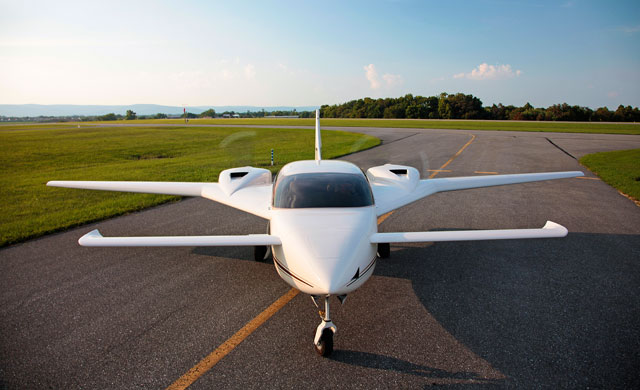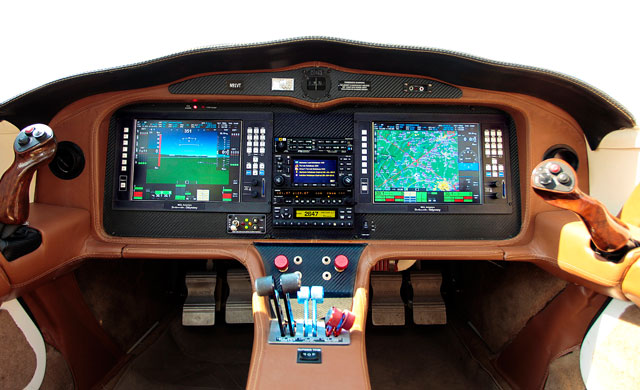February 01, 2013
Credit: Photo Credit: Dassault Falcon Jet Corp.
By Fred George fred_george@aviationweek.com
Digital electronic flight control systems, commonly known as
fly-by-wire (FBW) flight controls, increasingly are being used aboard
business aircraft because they reduce pilot workload, increase safety
margins, and prevent structural and aerodynamic limits from being
inadvertently exceeded. Most airframers also include many other
proprietary high-level functions and features in their FBW controls to
make the aircraft easier to handle during abnormal or emergency
conditions and thereby gain an advantage over other manufacturers.
In addition to the foregoing, “Fly-by-wire offers redundancy above
and beyond what’s necessary for certification. It’s a standout in that
respect,” says Glenn Zwicker, chief engineer at Parker Aerospace, a
leading provider of digital flight control hardware and software.
Airworthiness certification authorities typically require a one in 10
million probability of a catastrophic failure of a hydromechanical
flight control system. FBW systems, in contrast, must meet a one in one
billion probability of failure. Parker, among other leading FBW
manufacturers, targets one in 10 billion probability of failure, notes
Zwicker.
“This allows margin for common cause [catastrophic damage] associated
with rotor burst or tire failure, along with bird strike or bomb blast.
We design in multiple paths and multiple actuators to isolate local
damage,” he says.
FBW control systems have no mechanical connections between the
cockpit controls and the flight control actuators. Instead, as the name
implies, FBW systems have electrical links between the cockpit flight
controls and the power control actuators attached to the flight control
surfaces. The cockpit hand and foot controls have force and/or motion
sensors that measure pilot inputs. The inputs are transmitted as
electrical signals to the FBW system computers. Those boxes then send
electrical signals to command the movement of the power control
actuators that move the control surfaces.
In the most basic FBW Direct Law mode, control inputs by the flight
crew result in direct and proportionate movement of the flight control
surfaces. The only FBW components required are the electrical cockpit
control position or force transducers, actuator control units and the
electrohydraulic or all-electric power control actuators attached to the
flight control surfaces. There also is a feedback loop that senses when
the desired control surface deflection has been attained to tell the
system when to stop commanding more movement.
Direct Law, along with other FBW modes, also requires uninterruptable
electrical and hydraulic power supplies as there are no backup
mechanical links between the cockpit controls and flight control
surfaces or power control actuators. If all electrical and hydraulic
power is lost, the aircraft will not respond to stick, yoke or rudder
pedal inputs.
Direct Law doesn’t provide any of the higher level FBW functions that
distinguish digital flight controls from conventional
hydromechanical-powered flight controls. As with conventional flight
controls, it’s up to the flight crews to avoid inadvertent stall, or
over-speed, over-control and over-stress of the aircraft.
Higher level FBW functions, commonly known as Normal Law or Alternate
Law functions, require a second set of computers that are capable of
using inputs from several sensors, such as angle-of-attack (AOA),
flap/slat and landing gear position sensors, air data and IRS/AHRS,
weight-on-wheels and perhaps also radio altitude, as well as cockpit
controls. The computers then shape, smooth and calculate the best
aircraft behavior in response to pilot inputs, speed and configuration
changes and autopilot commands, as well as other factors. The higher
level law computers team with the actuator control units to determine
optimum flight control response.
However, the term “optimum” is subject to a wide variety of
interpretations depending upon the FBW flight control design
philosophies of each aircraft manufacturer. Some high-level FBW
functions, however, are common to virtually all civil aircraft and
include yaw, spiral, static and dynamic pitch stability augmentation to
reduce pilot workload. Most FBW systems also have soft or hard limiting
for maximum AOA, Vmo/Mmo over-speed and over-stress.
“Once you have the algorithms, it’s not difficult for the control
laws to accomplish such functions,” says David McLaughlin, Parker
Aerospace’s chief engineer for systems.
As noted, airframe manufacturers each add their own high-level FBW
functions in order to differentiate their digital flight control systems
from their competitors’ designs.
Dassault Aviation’s Falcon 7X, certified in 2007, is the first
business aircraft to be fitted with digital electronic flight controls.
Dassault borrowed liberally from the suite of military FBW technologies
that it developed in the mid-1980s for its longitudinally unstable,
highly maneuverable, Mach 2 Rafale fighter. It’s a vintage design that
has multiple components and several redundancies.
Dassault engineers believe that their extensive experience in
developing military digital flight control systems gives them FBW design
expertise not available to other business jet makers. Rafale’s handling
qualities, for example, are optimized for “carefree handling” and
protection from overstress and loss of control.
Rafale’s “gamma dot” FBW pitch function maintains the aircraft’s
velocity vector or flight path in a desired direction after the stick is
released. The aircraft will hold flight path while compensating for
changes in airspeed, c.g. and landing gear and high-lift configuration,
among other variables. Envelope protection prevents the aircraft from
stalling if AOA limits are exceeded, or from spinning in the event of
excessive sideslip. It also guards against overstress if the pilot
commands a higher g maneuver than the airframe can safely withstand.
Many of the Rafale’s FBW design features are carried over into the
Falcon 7X.
In a move similar to Rafale’s design, Dassault elected to fit the
Falcon 7X with outboard sidesticks instead of control wheel yokes for
pitch and roll command inputs. The sidestick configuration saves room in
the cockpit. However, the controls are not mechanically interconnected
and thus there is no motion cuing or tactile feedback between the two
sides. To compensate, the sidesticks vibrate a warning signal if both
pilots are attempting to control the aircraft at the same time. No such
stick input conflict cuing is built into two-seat versions of the
Rafale, but rather it sums the sidestick control inputs from both
cockpits. The Falcon 7X and Rafale retain mechanically interconnected
rudder pedals.
Adapting the Rafale’s FBW functionality for the Falcon 7X wasn’t much
of a challenge for Dassault’s engineers, for unlike its fighter
sibling, the 7X is inherently stable and designed to be flown at
subsonic speeds. FBW designers determined that the trijet’s digital
flight control system only needed a 50-millisecond response time, but
they elected to retain the 12.5-millisecond response built into the
Rafale’s computers to assure there would be no detectable latency in the
system. They also fitted the Falcon 7X with smaller, lower power,
lighter weight control surface actuators than those on the Rafale
because of the former’s executive transport mission.
Similar to the Rafale, the Falcon 7X’s digital flight control system
maintains aircraft flight path with speed and configuration changes; it
automatically trims the aircraft to neutralize primary control surface
forces and provides stability augmentation. It also has low-speed and
overstress flight envelope protection, plus it adds a high-speed
envelope protection function not needed in a Mach 2 aircraft. Dassault
designed the 7X for Mach 0.97 and 430 KIAS demonstrated dive speeds, but
the FBW system limits the aircraft to Mach 0.94 and 405 KIAS.
The Rafale’s FBW imposes no pitch angle limits, but the Falcon 7X’s
digital flight control system doesn’t allow nose attitude to exceed 35
deg. nose up or 28 deg. nose down at speeds above 250 KIAS. Nose-up and
nose-down pitch limits are reduced at slower speeds.
The Falcon 7X uses a radio altitude input to determine when to make
the transition between ground and air modes. Above 50-ft. radio
altitude, the aircraft will automatically trim the horizontal stabilizer
to maintain flight path when the sidestick is released, assuming it is
within the lower and upper speed limits. Below that radio altitude, auto
trim is inhibited. At touchdown on landing, a weight-on-main-wheels
command signals the horizontal stabilizer to start moving toward the
pitch-down position. This causes a natural feeling, derotation of pitch
attitude when the stick is released, helping the aircraft to transition
to a three-point attitude with weight on the main and nosewheels.
The Falcon 7X has no hard bank angle limits, but the FBW system
provides artificial spiral stability that automatically levels the wings
if the stick is released and bank angle is less than 6 deg. The
aircraft will hold bank angle if the stick is released at angles of 6
deg. to 35 deg. When the stick is released at bank angles greater than
35 deg., the aircraft automatically will roll back to 35 deg. Roll
stability augmentation also prevents the aircraft from rolling off due
to wing fuel imbalance or partial flight control system degradation.
Dassault installed three, single-channel digital computers plus a
dual-channel analog computer aboard the Rafale to provide the required
redundancy for such critical flight control functionality. The computers
vote on control surface commands, so one or even two errant computers
can be disqualified and excluded by the remaining computers.
If the Rafale FBW system has belt-and-suspenders redundancy, the 7X
has belt-suspenders-braces-hooks-and-loops redundancy. This assures that
it is controllable under all foreseeable abnormal or damaged
conditions. It has three full-function, dual-channel main flight control
computers (MFCCs) and three limited-function, single-channel secondary
flight control computers (SFCCs). The MFCCs are capable of high-level
normal, alternate (or degraded high level) and Direct Law modes while
the SFCCs only can function in Direct Law modes.
Only one of those six computers is needed to fly the aircraft. All
six send flight control-position commands to four actuator control and
monitoring units (ACMUs) that essentially are FBW command signal quality
assurance inspectors.
The ACMUs monitor the control surface commands coming from the main
and secondary flight control computers. In the event of a disagreement
between any of the MFCCs or SFCCs, the ACMUs can isolate and exclude
that computer from the system. The design assures the system has the
required 10-9 probability of failure.
But Dassault also installed a backup analog computer that provides an
alternate means of pitch and roll control. The extra computer thus
provides 10-10 redundancy similar to Parker Aerospace’s current systems.
The $20 million super-midsize Legacy 500 and $16 million Legacy 450
are the least expensive business aircraft yet to be fitted with full
three-axis, digital FBW flight controls. Embraer chose FBW to reduce
pilot workload, improve passenger ride comfort, enhance airport
performance and save weight.
Similar to the Falcon 7X, the Legacy 450 and 500 have sidestick
controllers that are not mechanically interconnected. Similar to the
Rafale, the sidestick inputs are summed. The rudder pedals, however, are
mechanically interconnected.
The Legacy 450 and 500, similar to the Falcon 7X and Rafale, have
“gamma dot” flight path stability, a control function that maintains
aircraft trajectory with speed and configuration changes so long as the
aircraft remains within low- and high-speed flight envelope limits.
Pitch trim is automatic.
The high-level control laws have both ground and air modes, but the
transition doesn’t use radio altitude. For instance, upon landing, the
FBW system makes the transition from gamma dot flight path stability to
speed stability after the landing gear and flaps are extended. Changes
in speed cause nose-up or nose-down pitch changes. A trim reset button
on the sidestick enables the flight crew to immediately retrim the
aircraft for a new trim reference speed, thereby relieving the need to
hold nose-up or nose-down sidestick pressure.
Embraer also included a heading and roll thrust asymmetry
compensation control law that takes most of the work out of handling an
engine-out emergency. The FBW system, though, retains enough sideslip to
provide the crew with an unmistakable indication of which engine has
failed. A flight director cue tells the pilots how much sideslip to add
in the direction of the operative engine to optimize
one-engine-inoperative climb performance.
Rather than taking Dassault’s approach of developing the entire FBW
system for its business aircraft in-house, Embraer subcontracted with
Parker Aerospace and BAE Systems to save time and cost. Parker’s and BAE
Systems’ hardware architecture for the Legacy 450 and 500 is much
simpler than that of the Falcon 7X, but it delivers virtually identical
benefits and system reliability.
The Legacy 450 and 500 have two, dual-channel, primary flight control
computers furnished by BAE Systems that host high-level control law
functions, such as stability augmentation, high- and low-speed envelope
limiting and overstress protection. This is one of the latest quadruplex
designs that uses four dissimilar channels, each one of which is
capable of controlling the aircraft through all flight control surface
actuators in all three axes.
The PFCCs send commands to three, multiple channel remote electronics
units (REUs), also known as actuator control electronics (ACEs) boxes
in other civil aviation sectors. The REUs, also supplied by Parker, only
are capable of Direct Law flight control surface actuation solely in
response to cockpit control inputs. The design architecture is similar
to that on the Boeing 787, except that the jetliner has triple PFCCs and
quad-redundant ACEs.
The PFCCs combine pilot control inputs from the REUs with inputs from
various sensors, such as AOA, speed, configuration and vertical
acceleration, among others, to calculate the appropriate flight control
actuator commands based upon higher level Normal control laws. The PFCCs
send back the Normal Law control response to the triple REUs that then
command the movement of the flight control actuators.
Parker also furnishes most of the FBW software, along with the flight
control surface actuators and other hardware, used aboard the aircraft.
Embraer’s high-level Normal Law functions include both soft- and
hard-limit protection. Within the normal flight envelope, there are
+30-deg. /-15-deg. soft pitch and 33-deg. roll limits, along with 1.1 Vs
minimum speed and Vmo limits, that can be overridden by maintaining
lateral or longitudinal sidestick pressure. Beyond these soft limits,
there are hard vertical acceleration, sideslip, maximum AOA and
high-speed limits that cannot be overridden. There are no hard pitch or
roll angle limits.
Embraer engineers believe the hard maximum AOA limits enable the
designers to take advantage of lower takeoff and landing V speeds to
improve airport performance. For users, this translates into a payload
increase of up to 900 lb. when operating off of short runways, Embraer
officials assert. AOA limit also enables flight crews to extract maximum
performance from the aircraft during wind-shear escape or controlled
flight into terrain (CFIT) avoidance maneuvers.
Engineers in Savannah took a different FBW design approach than other
business jet manufacturers, assuring that the G650 has high redundancy
with the minimum number of components. Two dual-channel primary flight
control computers (FCCs) are supplied by Thales. The FCCs host the
high-level control laws. Each has two computing and two monitoring
cards, eliminating the need for stand-alone monitoring computers.
Similar to Embraer’s layout for the Legacy 450/500, the G650′s dual
primary flight control computers provide four dissimilar flight control
command channels, any one of which can control all flight control
surface actuators.
Unlike Dassault’s and Embraer’s FBW designs, Gulfstream elected to
fit the aircraft with individual remote electronics units boxes, or
ACEs, integrally mounted with each of the flight control surface
actuators. The 16 hybrid REU/electrohydraulic system actuators (EHSAs)
are also made by Parker.
The basic FBW design meets the 10-9 probability of failure required
for certification, but Gulfstream wanted an additional level of
redundancy to provide 10-10 probability of failure. So, the G650 has a
fully autonomous, three-axis backup flight control system (BFCS)
computer made by Thales that complements the dual primary flight control
computers. It sends its commands to one of two REUs that signal the
movement of the flight control surface actuators on the left and right
ailerons, left and right outboard spoilers, left and right elevators and
the rudder.
The G650 only has two hydraulic systems, rather than the three
required for most FBW flight control systems. To meet the triplex power
requirement, Gulfstream and Parker Aerospace teamed to create the
aviation industry’s first dual-mode flight control actuators.
These components are known as electric backup hydrostatic actuators,
EBHAs for short. They function as conventional EHSAs if hydraulic power
is available. However, in the event of hydraulic system failure, the
actuators revert to a backup mode that uses tiny electrically powered
hydraulic pumps mounted on the actuators. The actuator electric pumps
generate the fluid power required to move the control surface. The
design eliminates the need for a full-time, electrically powered third
hydraulic system, thereby saving considerable system weight.
In the event of failure of both primary flight control computers and
both hydraulic systems, the backup flight control unit sends commands
directly to the EBHAs.
And if both engine-driven generators were to fail, the G650′s 15 KVA
ram air turbine (RAT) can be extended to generate emergency electrical
power to supply the FBW system. Below 180 KIAS, 24 VDC emergency
batteries take over from the RAT to assure an uninterruptable power
supply to all electrical components in the FBW system.
Following Boeing’s lead on the 777 and 787, Gulfstream elected to
retain a conventional control yoke wheel for the G650 instead of fitting
the aircraft with sidestick controllers. The yokes add weight, cost and
complexity, but they are mechanically interconnected so that the pilot
not flying can see and feel the pilot flying’s control inputs.
Gulfstream and Boeing engineers assert that the design promotes crew
situational awareness and enhances crew resource management.
The G650′s high-level Normal Laws, hosted by the dual primary flight
control computers, are quite similar to those of the Boeing 787. The
basic pitch law is similar to the 787′s C*U design. C* means that
fore/aft yoke movement commands pitch rate by means of a simple Direct
Law mode on the ground and vertical acceleration, or g rate, in the air
using several inputs to the FCCs. U means that the aircraft is speed
stable, so the pilot must trim nose up or down with speed change.
Three-axis stability augmentation makes the aircraft easy to fly
because it compensates for trim changes caused by control surface or
landing gear extension or retraction. Similar to the 787, the G650′s FBW
system has a maneuver load alleviation function that progressively
deflects the ailerons and outboard spoilers at 1.5 g’s and above to
reduce the lift produced by the outboard wing sections and thus the wing
bending moment. Other high-level control functions include automatic
retraction of the speed brakes under certain conditions, dynamic rudder
travel limiting to prevent overstress of the vertical fin, and elevator
split limiting to prevent overstress of the empennage.
Similar to Boeing and Embraer FBW designs, the G650 has no hard
limits on pitch or roll angles. However, the system does have hard limit
maximum AOA and high-speed flight envelope protections in the Normal
Law mode.
If air data or IRS information is insufficient or not available, the
FCCs revert to Alternate Law mode. The autopilot becomes inoperative and
flight envelope protections are degraded. If all four channels of the
primary FCCs are unavailable, the FBW system reverts to Direct Law mode
in which the control surfaces respond directly and proportionately to
cockpit flight control inputs.
Bombardier has announced that its two new ultra-long-range,
high-speed business jets, the Global 7000 and Global 8000, will be
fitted with FBW controls. Many components will be supplied by Parker
Aerospace.
Many other general aviation manufacturers are likely to follow. Most
early adopters will fit FBW controls to aircraft that otherwise would
require conventional powered flight control surface actuators. But
future light and medium business aircraft may feature some form of FBW
because maneuver load alleviation and flight envelope protection may
enable engineers to reduce structural weight, thereby improving fuel
efficiency and increasing tanks-full payload.
Plainly put, FBW aircraft are easier to fly than aircraft with
conventional flight controls. Optimum stability and control response
characteristics can be written into the high-level primary flight
control computer software codes, transforming a marginally stable, but
aerodynamically superior airplane into the most docile handling ship in
the air. Flight envelope protections enable pilots to fly the aircraft
closer to stall and high-speed margins so that they can safely,
consistently and confidently extract more performance out of the
aircraft when needed.
But potential aircraft design and development cost reduction is the
main incentive for airframe manufacturers. Future designs can be lighter
weight, more aerodynamically efficient and even longer lasting because
of FBW’s stability augmentation, maneuver load alleviation and flight
envelope protection capabilities. Flight test development programs
should be shorter because FBW software will assure that aircraft
consistently meet stability and control standards set by airworthiness
certification authorities. Any shortcomings on the path to certification
will be corrected by rewriting code in a few hours rather than having
to paste on new aerodynamic bandages such as vortex generators, stall
strips and wing fences.
In a few of decades, fly-by-wire on new turbine aircraft could become
as common as throttle-by-wire, steer-by-wire and brake-by-wire on
current aircraft. That development could make new models so much more
efficient, as well as easier to fly than older models, that fleet
replacement might accelerate at an unprecedented pace. BCA








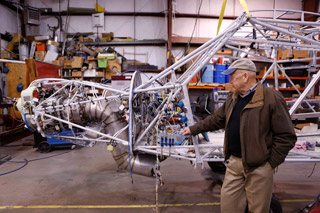 Company owner Glen Gordon is realizing his dream of certifying the Sherpa 650T.
Company owner Glen Gordon is realizing his dream of certifying the Sherpa 650T.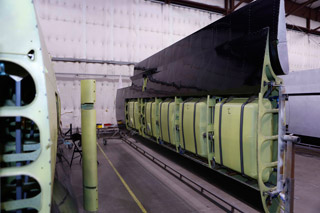 The new wings are fatter and longer than the original demonstrator, and contain 10 gas tanks.
The new wings are fatter and longer than the original demonstrator, and contain 10 gas tanks.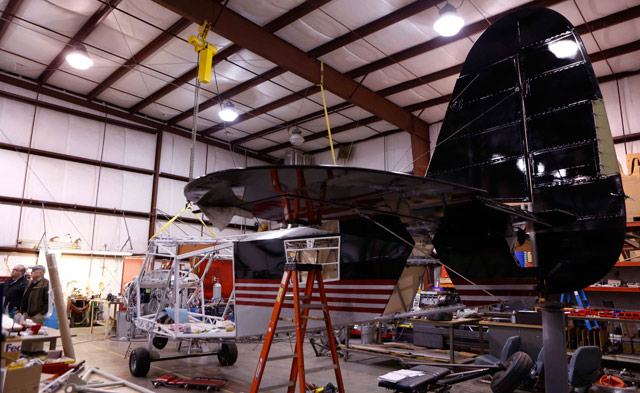 Funding
from a Chinese investor will support 24 months of certification for the
eight-place Sherpa K650T, seen here, and the six-place Sherpa K500.
Funding
from a Chinese investor will support 24 months of certification for the
eight-place Sherpa K650T, seen here, and the six-place Sherpa K500.
